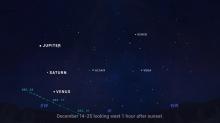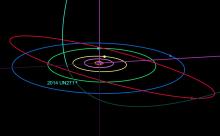Listen to today's episode of StarDate on the web the same day it airs in high-quality streaming audio without any extra ads or announcements. Choose a $8 one-month pass, or listen every day for a year for just $30.
You are here
Oort Cloud
The most remote member of the solar system yet seen is a ball of ice nicknamed FarFarOut. Estimates say it’s about 13 billion miles from the Sun — 140 times farther than the distance between Earth and the Sun.
But that’s right next door compared to the farthest objects of all — the members of the Oort Cloud. It could extend about 1,400 times farther than FarFarOut — more than three light-years in every direction. Although no one has seen it, the orbits of many comets suggest they must have come from such a cloud.
The inner part of the cloud begins at about 2,000 times the Earth-Sun distance. It’s shaped like a thick doughnut, and gets thicker near its outer edge.
The outer part of the cloud begins at about 20,000 times the Earth-Sun distance. It forms a shell that encircles the Sun.
The Oort Cloud is populated by perhaps trillions of chunks of ice and rock. They could be leftovers from the birth of the solar system that were kicked out by the gravity of the giant planets.
On the other hand, many of them could have formed around other stars in the cluster that gave birth to the Sun. The stars all exchanged iceballs before they moved apart.
Most estimates put the outer edge of the Oort Cloud at up to a hundred thousand times the Earth-Sun distance. But it could extend twice as far. At that range, the gravity of the rest of the galaxy would pull the objects away from the Sun — and out of the Oort Cloud.
Script by Damond Benningfield





